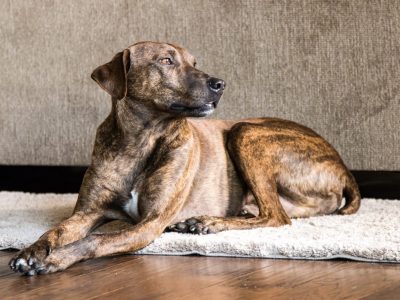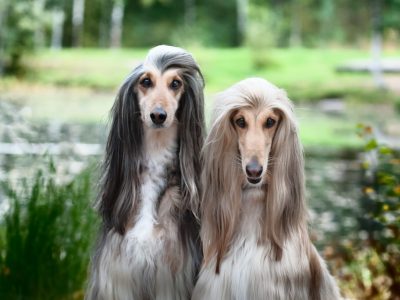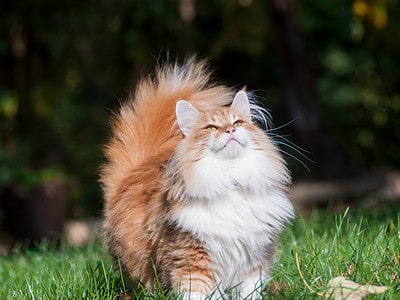Common European Adder
Vipera berus
European adders are the only snake that lives above the Arctic Circle.
Advertisement
Common European Adder Scientific Classification
- Kingdom
- Animalia
- Phylum
- Chordata
- Class
- Reptilia
- Order
- Squamata
- Family
- Viperidae
- Genus
- Vipera
- Scientific Name
- Vipera berus
Read our Complete Guide to Classification of Animals.
Common European Adder Conservation Status
Common European Adder Facts
- Prey
- Small mammals, lizards, amphibians, and sometimes bird eggs.
- Main Prey
- Small mammals such as mice, shrews, and rats.
- Group Behavior
- Solitary
- Fun Fact
- European adders are the only snake that lives above the Arctic Circle.
- Biggest Threat
- Predators during its hibernation
- Most Distinctive Feature
- Dark zigzag pattern down the length of the back, and V or X shaped marking on their head.
- Other Name(s)
- Common European viper, European viper, adder, common adder, common viper, crossed viper, European adder, European common viper, northern viper, cross adder, hogorm, hoggorm, kyykäärme, hugorm
- Temperament
- Timid
- Litter Size
- 3-20
- Habitat
- Forest edges, countryside, river banks
- Diet for this Fish
- Carnivore
- Lifestyle
- Diurnal
- or Nocturnal Depending on Region and Season
- terrestrial
- Common Name
- Common adder, black adder, European adder
View all of the Common European Adder images!

The common European adder is the only snake that lives above the Arctic Circle.
This snake, also known as the black adder, is the most common venomous snake in Europe. It ranges far and wide across Europe and Asia. In the northern areas of its range, it is often the only snake species. It is a short, somewhat stocky snake that found a way to adapt to the cold. Sometimes its young are born while it hibernates.
Amazing Facts About Common European Adders
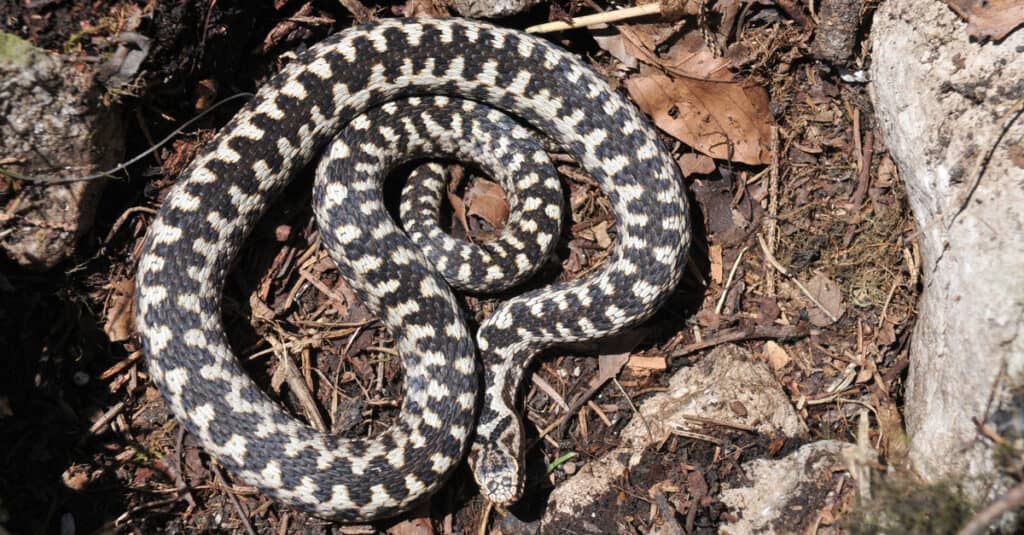
Male European adders are usually silvery-gray in color, and thinner than the females.
©/Shutterstock.com
- Unlike most snakes, common European adders are sexually dimorphic. The females tend towards shades of brown in their colors, and males tend toward blacks and greys.
- Occasionally, a common European adder is solid black; if you encounter one, it will most likely be female.
- Their young may stay near their mother for a few days after being born.
Where to Find Them
These snakes are widely distributed across Europe and Asia. They are found as far south as Greece, east into northern China, north to Scandinavia, and west to Great Britain. Common European adders are the only snake to live above the arctic circle and have adapted to the cold better than other snakes. They spend as many as 9 months a year hibernating through the cold months, and females may only breed every couple of years.
They are terrestrial and spend the majority of their time on the ground, where they hunt for ground-nesting birds and small mammals. Common European adders are diurnal in most areas within their range, however, in southern areas they may also be active at night. You’re most likely to encounter one along the edges of woods, or out in the countryside; however, they sometimes climb banks and small bushes to bask or get to prey.
Evolution and Origins
These snakes have a broad distribution spanning Europe and Asia, inhabiting regions as far south as Greece, extending eastward to northern China, reaching north into Scandinavia, and even found in Great Britain, with common European adders being the sole snakes capable of surviving above the arctic circle and displaying superior cold adaptation compared to other snake species.
Scientific Name
As members of the Viperinae subfamily of Viperidae, common European adders are considered true adders. This subfamily is endemic to Europe, Asia, and Africa, and includes about 13 genera. They’re sometimes called pitless vipers, because, unlike their Crotalinae (pit viper) cousins, they don’t have heat-sensing pits between their nostril and eye.
The name adder originates in Old English as næddre and became “adder” later on. Originally, it was only used in reference to serpents. Later, people applied it primarily to venomous snakes or snakes that looked like venomous snakes. As a result, there are numerous snakes that are often called adders but aren’t considered true adders.
According to etymonline.com:
“Since Middle English restricted to use as the common name of the viper, the only poisonous British reptile (not generally fatal to humans), then by extension applied to venomous or similar snakes elsewhere (puff-adder, etc.).”
Types of Adders
True Adders
True adders, also called true vipers, pitless vipers, and Old World vipers, are endemic to Europe, Asia, and Africa. They have hinged fangs, which allow them to grow relatively long, and those hollow fangs are attached to venom glands.
The true adders include over 90 species spread across 13 genera.
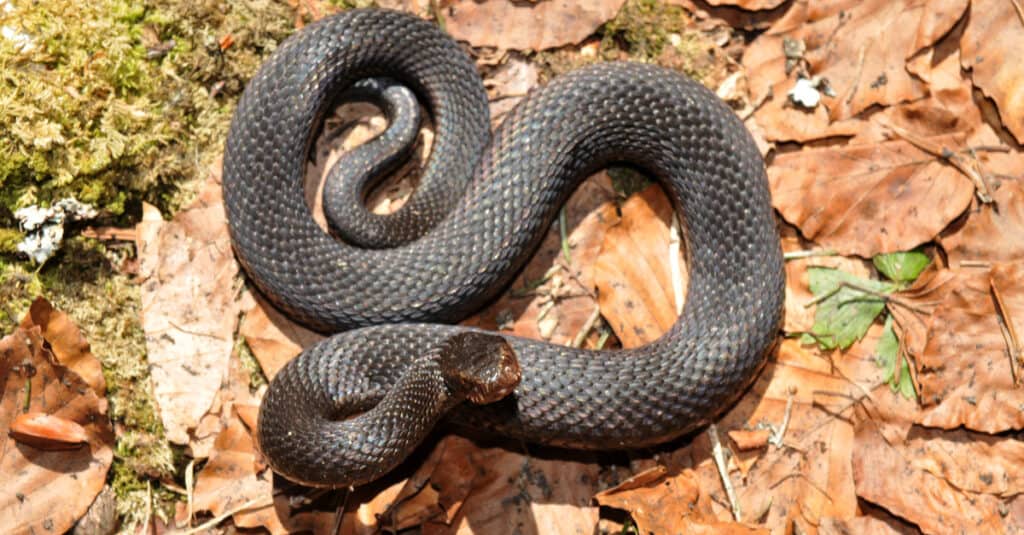
Black adders occasionally appear, they’re usually female.
©Simlinger/Shutterstock.com
- Bush vipers (Atheris sp.) live in subsaharan Africa in tropical forests.
- Puff adders (Bitis sp.) inhabit most of Africa, and the southern Arabian Peninsula, and include the Gabon viper, horned adder, and Peringuey’s adder
- Night adders (Causus sp.) occur in Africa.
- Horned vipers (Cerastes sp.) range extends from north Africa east through Arabia and Iran.
- Day adders (Daboia sp.) occur in Pakistan and India, east into China and other parts of East Asia.
- Saw-scaled adders (Echis sp.) are also called carpet vipers. They occur in Africa north of the equator, parts of the Middle East, and India and Sri Lanka; they include the.
- McMahon’s viper (Eristicophis macmahonii) inhabit near the Iran-Afghanistan-Pakistan border in the desert region of Balochistan.
- Large palearctic vipers (Macrovipera sp.) northern Africa, Middle East, and the Milos Archipelago in the Aegean Sea.
- Kenya mountain viper (Montatheris hindii) is endemic to Kenya at altitudes from 8,900-12,900 feet on Mount Kenya, and the moorelands of the Aberdare mountain range.
- Upland vipers (Montivipera sp.) inhabit the Middle East.
- Lowland viper (Proatheris superciliaris) lives in southern Tanzania, Malawi, and Mozambique.
- False-horned vipers (Pseudocerastes sp.) occur from Egypt to Pakistan.
- Palearctic vipers (Vipera sp.) are the most widespread. There are 21 species in this genus, and they inhabit Great Britain, nearly all of continental Europe (including the Arctic Circle), some islands in the Mediterranean and Aegean Seas, northern Asia, northern Africa, and North Korea. Common European adders are in this genus; many snakes in the Vipera genus share similar markings, i.e., variations in zigzag pattern.
Other Adders
Some snakes share physical characteristics with true adders, even if they aren’t venomous – or even vipers.
- Death adders are one of the most venomouse snakes in the world. They inhabit areas of Australia, and are more closely related to cobras and coral snakes; even though they have similar physical features to the true adders.
- Western hognose snakes are sometimes called puff adders because they puff their bodies up as part of their defensive display. They have an elaborate “dead snake” routine that they use to escape predators, but are not at all dangerous to people. They occur in the southeastern United States.
Population and Conservation Status
In many areas, the common European adder population is declining. They are a protected animal in the United Kingdom, for example, where their population is diminishing and biologists believe they may become extinct in as little as 12 years. There, genetic studies are underway to determine the species’ genetic diversity and population viability. In other areas of their range, they are still very common. According to the IUCN Redlist, they’re categorized as least concern, although they acknowledge that worldwide populations are diminishing. Rapid human expansion into the areas in which these snakes make their home is partly to blame but in some areas, non-native wildlife also impacts their population stability.
Identifying: Appearance and Description

Melanistic (dark-colored) adders exist too.
©Edwin Godinho/Shutterstock.com
Males and females of this species have a strong zigzag pattern on their backs and a v-shaped marking on the tops of their heads. The common European adder is one of the few snake species that are sexually dimorphic; females are in shades of brown, with a light brown base color and males have a bright silver base color that makes the zigzag pattern even more striking. They have strongly keeled scales that give their skin a rough texture.
These snakes are stocky but relatively small, as vipers go, and most average 2 feet long. However, the females are generally larger and have been known to reach 5 feet in length. Juveniles are born (not hatched) looking like miniatures of their parents and measure between 3 and 5 inches.
Common European adders vary in size according to where they live; the further north they live, the smaller they are. They’re mostly terrestrial but sometimes climb small bushes or hills to bask or hunt. These snakes often hibernate during colder months; some hibernate for as many as 8 to 9 months out of the year. Many do not survive hibernation, and juveniles are the most susceptible.
Venom: How Dangerous Are Common Adders?

Females of the species tend towards being more earthy-colored.
©/Shutterstock.com
Like other vipers, common adders have hollow, hinged fangs attached to a venom gland, which act much like hypodermic needles. When they bite, they inject venom into their victim (be it prey or a defensive bit). Sometimes they don’t inject any venom which are called dry bites. While common adders are venomous, they aren’t considered very dangerous. Bites are becoming common due to human expansion into their range; in about 70% of cases, there is either a very small reaction or only localized effects. Except for a very small number of cases that require hospital treatment, effects from a bite are unpleasant but typically easy to treat. Fatalities from this snake are exceedingly rare.
All that said, it’s still a venomous snake, so don’t handle it unless you are properly trained because most bites happen as a result of handling or stepping on this snake.
Common Adder: Behavior and Humans
These are timid snakes and will escape if at all possible before biting. Most bites occur because the snake was either stepped on or picked up by someone. While the IUCN Redlist doesn’t consider them endangered or threatened, their biggest threat is habitat fragmentation and invasive wildlife.
Like many snakes, they’re great rodent control and will try to avoid you, given the chance.
Similar Animals
View all 235 animals that start with CCommon European Adder FAQs (Frequently Asked Questions)
Are common European adders venomous?
Yes, they are venomous; however, biologists consider their venom less dangerous than that of other vipers.
How do common European adders hunt?
This species is both an ambush predator and an active hunter.
Are common European adders aggressive?
No, they’re actually timid and would rather escape than attack. Most bites happen because someone stepped on or picked up an adder.
Where do common European adders live?
They’re most widespread of all the vipers and inhabit most of continental Europe including Great Britain, east to northern China, and south to Greece.
What do common adders eat?
They eat a variety of small animals including mice, ground-nesting birds, and lizards.
Thank you for reading! Have some feedback for us? Contact the AZ Animals editorial team.
Sources
- Adder | Woodland Trust, Available here: https://www.woodlandtrust.org.uk/trees-woods-and-wildlife/animals/reptiles-and-amphibians/adder/
- Reptile Database, Available here: https://reptile-database.reptarium.cz/species?genus=Vipera&species=berus
- IUCN Redlist, Available here: https://www.iucnredlist.org/species/47756146/743903









